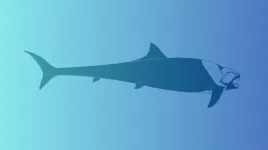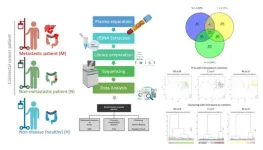(Press-News.org) A new study by Case Western Reserve University PhD student Russell Engelman published in PeerJ Life & Environment attempts to address a persistent problem in paleontology – what were the size of Dunkleosteus and other late Devonian arthrodire placoderms. Arthrodire placoderms are extinct fishes with had armor covering their head and part of their torso, but like sharks the rest of their skeleton was made of cartilage, meaning most of their body did not preserve when they became fossilized.
Previous size estimates for Dunkleosteus were largely based on this animal’s mouth and jaws, but these methods were never tested to see if they reliably estimated the size of placoderms. This study sought to test these methods by using data from modern sharks and other fishes and testing if they accurately predicted body size in Dunkleosteus and smaller arthrodire placoderms known from complete remains. Because these smaller species are known from complete remains, they could be used to test whether previous methods accurately predicted body size in arthrodires.
“Length estimates of 5–10 m have been cited for Dunkleosteus for years,” Engelman said, “but no one seems to have checked these methods statistically or tested if they produce reliable or reasonable results in arthrodires.”
It turned out mouth measurements of sharks did not accurately predict the body size of arthrodires. Complete arthrodires always had larger mouths at the same body length as sharks, and this caused mouth measurements of complete arthrodires to produce body length estimates 2–2.5 times their actual size. Dunkleosteus had an unusually large mouth even among arthrodires, further calling into question if the mouth and jaw parts of these smaller forms can be used to estimate the size of this Devonian giant.
Previously estimated lengths for Dunkleosteus also resulted in a biologically illogical body shape when applied to the known dimensions of the fossils. If previous lengths were accurate, the resulting fish would have had an extremely small, shrunken head and hyper-elongate torso even more longer than the proportions seen in most eels, at odds with a previous study published in PeerJ suggesting a shorter body more similar to pelagic sharks. The long shape implied by earlier studies would have also made the animal’s gills so small relative to its body the fish would have likely suffocated. No other arthrodires showed such extreme proportions, even though estimates based on mouth dimensions suggested they should, suggesting these prior length estimates are highly unlikely for Dunkleosteus.
Overall, this suggests mouth dimension in sharks cannot be used to predict the length of arthrodires and most previously cited lengths for large members of this group are overestimates, in agreement with the conclusions of a previous study by the same author. Arthrodires simply have much larger mouths relative to their body length than sharks, with relative mouth widths more similar to predatory catfishes.
“Dunkleosteus has often been assumed to function like a great white shark,” Engelman said, “but as we learn more about this fish it might be more accurate to describe it as a mix of shark, grouper, viperfish, tuna, and piraiba [a type of giant predatory Amazonian catfish, well known to fans of Animal Planet’s River Monsters]"
However, although it may be disappointing that these giant Devonian fishes were not as giant as once thought, the recognition these animals have large mouths is still important. As apex predators of the Devonian, accurately estimating the body length and proportions of arthrodires is critical for reconstructing their life habits and the ecology of the Devonian in general. In fact, despite frequently being reconstructed based on sharks, this study notes the large mouths of arthrodires suggest arthrodires could attack much larger prey relative to their body size than living sharks. This suggests while arthrodires have often been reconstructed based on comparisons with sharks, the two may have behaved more differently than previously thought.
"Mouth size is probably the biggest factor in determining the largest prey a fish can eat," Engelman said, "the results of this study suggest arthrodires were hitting far above their weight class."
END
Giant, swimming mouths: Oral dimensions of extant sharks do not accurately predict body size in Dunkleosteus terrelli (Placodermi: Arthrodira)
2023-04-10
ELSE PRESS RELEASES FROM THIS DATE:
Scheduled childbirth may greatly reduce preeclampsia, a leading cause of maternal death
2023-04-10
Research Highlights:
Analysis found that more than half of preeclampsia cases that occur during weeks 37-42 of pregnancy (called at-term preeclampsia) may be prevented with timed birth, such as a scheduled induction or Cesarean delivery.
Planned labor inductions and Cesarean deliveries are already widely practiced for a range of reasons, however, they are seldom considered as an intervention to prevent at-term preeclampsia, which may be life-threatening.
Embargoed until 4 a.m. CT/5 a.m. ET Monday, April 10, 2023
DALLAS, April ...
Non-biological factors and social determinants of health important in women’s CVD risk assessment
2023-04-10
Statement Highlights:
A new American Heart Association scientific statement reviews research about racial and ethnic differences in cardiovascular risk factors among women in the U.S.
In addition to traditional risk factors, women of underrepresented races or ethnicities experience challenges in the diagnosis and treatment of cardiovascular conditions due to language barriers, discrimination, difficulties in acculturation or assimilation, lack of financial resources or health insurance, or lack of access to health care.
Women of racial and ethnic backgrounds other than white have been underrepresented ...
Study finds record-breaking rates of sea-level rise along the U.S. Southeast and Gulf coasts
2023-04-10
Sea levels along the U.S. Southeast and Gulf coasts have been rapidly accelerating, reaching record-breaking rates over the past 12 years, according to a new study led by scientists at Tulane University.
In the study, published in Nature Communications, researchers said they had detected rates of sea-level rise of about a half an inch per year since 2010. They attribute the acceleration to the compounding effects of man-made climate change and natural climate variability.
“These rapid rates are unprecedented over at least the 20th century and they have been three times higher than the global average over the same period,” says Sönke ...
New guidelines on catatonia aim to create a step-change in management
2023-04-10
For the first time, the British Association for Psychopharmacology (BAP) has produced a guideline on catatonia. Catatonia is a severe psychiatric disorder that has been associated with a wide range of medical complications. Yet recognition and management remain poor.
Twenty-two experts from across three continents examined the latest research on this important condition and have developed a series of recommendations ranging from diagnosis and investigation to treatment. According to the lead author, Dr Jonathan Rogers of University ...
Targeted testing for HIV in hospital emergency departments has great potential, Spanish researchers say
2023-04-10
**Note: the release below is a special early release from the European Congress of Clinical Microbiology & Infectious Diseases (ECCMID 2023, Copenhagen, 15-18 April). Please credit the conference if you use this story**
Embargo: 2301H UK time Sunday 9 April
**Note – the press release is available in Spanish and Portuguese, see links below**
Targeted testing for HIV in emergency departments has great potential for increasing diagnoses, this year’s European Congress of Clinical Microbiology & Infectious Diseases (ECCMID) in Copenhagen, Denmark, (15-18 April), will ...
Engineered plants produce sex perfume to trick pests and replace pesticides
2023-04-10
By using precision gene engineering techniques, researchers at the Earlham Institute in Norwich have been able to turn tobacco plants into solar-powered factories for moth sex pheromones.
Critically, they’ve shown how the production of these molecules can be efficiently managed so as not to hamper normal plant growth.
Pheromones are complex chemicals produced and released by an organism as a means of communication. They allow members of the same species to send signals, which includes letting others know they’re looking for love.
Farmers can hang pheromone dispersers among their crops to mimic the signals ...
Future is bright for gold-based antibiotics
2023-04-08
**Note: the release below is a special early release from the European Congress of Clinical Microbiology & Infectious Diseases (ECCMID 2023, Copenhagen, 15-18 April). Please credit the conference if you use this story**
Embargo: 2301H UK time Friday 7 April
New research being presented at this year’s European Congress of Clinical Microbiology & Infectious Diseases (ECCMID) in Copenhagen, Denmark, (15-18 April) has identified several gold-based compounds with the potential to treat multidrug-resistant “superbugs”.
With ...
How to see the invisible: Using the dark matter distribution to test our cosmological model
2023-04-07
It feels like a classical paradox: How do you see the invisible? But for modern astronomers, it is a very real challenge: How do you measure dark matter, which by definition emits no light?
The answer: You see how it impacts things that you can see. In the case of dark matter, astronomers watch how light from distant galaxies bends around it.
An international team of astrophysicists and cosmologists have spent the past year teasing out the secrets of this elusive material, using sophisticated computer simulations and the observations from the one of the most powerful astronomical cameras in the world, the Hyper Suprime-Cam (HSC). The team is led by astronomers from Princeton ...
Four different autism subtypes identified in brain study
2023-04-07
People with autism spectrum disorder can be classified into four distinct subtypes based on their brain activity and behavior, according to a study from Weill Cornell Medicine investigators.
The study, published March 9 in Nature Neuroscience, leveraged machine learning to analyze newly available neuroimaging data from 299 people with autism and 907 neurotypical people. They found patterns of brain connections linked with behavioral traits in people with autism, such as verbal ability, social affect, and repetitive or stereotypic behaviors. They confirmed that the four autism subgroups could also be replicated in a separate dataset ...
New method of clustering colorectal cancer patients using DPE sequencing
2023-04-07
“[...] DPE analysis may have an important role in improving the diagnosis and management of CRC.”
BUFFALO, NY- April 7, 2023 – A new editorial paper was published in Oncoscience (Volume 10) on March 23, 2023, entitled, “New method of clustering colorectal cancer patients using differential presence of exons (DPE) sequencing.”
Colorectal cancer (CRC) is a heterogeneous disease that occurs in the colon and the rectum, parts of the gastrointestinal system. CRC is the third leading cause of cancer-related ...




